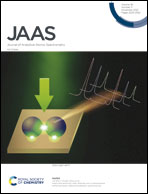Laser-ablation dependence of fiber-laser-based laser-induced breakdown spectroscopy for determining Cu, Mg, and Mn elements in aluminum alloys
Abstract
Fast elemental analysis is essential in aluminum alloy manufacture. In this work, the fast determination of copper, magnesium, and manganese elements in aluminum alloys using laser-induced breakdown spectroscopy based on fiber laser ablation (FL-LIBS) was experimentally studied. With a high repetition rate and low pulse energy of the fiber laser, the laser-ablation dependence, including laser spot overlap, non-overlapping ablation area, scan speed (moving speed), and single pulse energy, was investigated in detail. A linear function correlation between the intensity and non-overlapping ablation area was demonstrated. The function correlation between spectral intensity, SPPN and moving speed was also derived and demonstrated. With the increase of single pulse energy, the spectral intensity became stronger without the plasma shielding effect in the FL-LIBS system. The mechanism of frequency, movement speed, and single pulse energy affecting laser ablation had been fully explored. With optimized laser-ablation, the analytical performance of Cu, Mg, and Mn elements using FL-LIBS in aluminum alloys was evaluated. The R2 of the FL-LIBS system for Cu I 327.4 nm, Mg I 383.8 nm, and Mn I 403.0 reached 0.99884, 0.99843, and 0.99896, respectively; the root mean square error of cross-validation (RMSECV) of the FL-LIBS system for these three elements reached 0.0103 wt%, 0.0384 wt%, and 0.0295 wt%, respectively; the average relative errors (AREs) and average relative standard deviations (ARSDs) of the FL-LIBS system for these three elements were less than 5%; this study provides a fast, stable and accurate method for elemental analysis of aluminum alloys.



 Please wait while we load your content...
Please wait while we load your content...